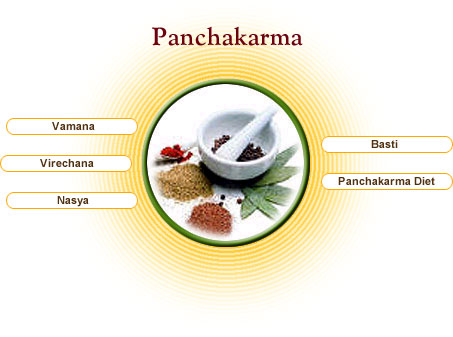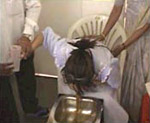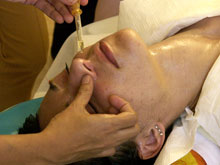Pancha Karma

Pancha Karma is the cornerstone to Ayurvedic management of disease.Pancha Karma is the process which gets to the root cause of the problem andcorrects the essential balance of 'Tridosha' in body. Pancha Karma is not onlygood for alleviating disease but is also a useful tool in maintaining excellenthealth. Ayurveda advises undergoing Pancha Karma at the seasonal changes toclean the body, improve the digestion and to improve the metabolic processes.
Panchakarma is a Sanskrit word that means "five actions" or" five treatments". This age-old science of purifying the body is an ancient branch of Ayurveda, The Treatment in Ayurveda consists of two main types.
One is Shaman Chikitsa, used to subdue the vitiated Doshas, due to which any ailments may be produced. It is administered by using various medicinal herbo- mineral preparations.
However, if the Doshas are vitiated beyond a particular level, they give rise to various endotoxins, which have a tendency to be accumulated in the minute channels. These are beyond the level of pacification and hence need to be eliminated or removed from the body. In such cases, the second type of treatment, which is ShodhanChikitsaor cleansing therapy, is indicated. Since it consists of the five types of main therapies, it is known as the PanchakarmaChikitsa.
Panchakarma has been given a special place in all the ancient Ayurvedic texts. AacharyaCharak, the author of the most important ancient text on internal medicine, has described a wide use of Panchakarma therapy for almost all the major diseases. Two separate sections, KalpaSthanam, and Siddhi Sthanam in CharakSamhita describe the details of special decoctions and other preparations used for Panchakarma therapy.
Five Basic Shodhans: Cleansing Methods
-
Vaman
Vaman: Emesis Therapy

When there is congestion in the lungs causing repeated attacks of bronchitis, colds, cough or asthma, the Ayurvedic treatment is therapeutic vomiting, vaman, to eliminate the kapha causing the excess mucus. First, after the snehan and swedan, three to four glasses of licorice or salt water is administered, then vomiting is stimulated by rubbing the tongue which triggers the vomiting center through the gag reflex. One may alternatively take two to three glasses of salt water which will also aggravate kapha and then rub the tongue to induce vomiting. Once the mucus is released the patient will feel instantly relieved. It is likely that congestion, wheezing and breathlessness will disappear and that the sinuses will become clear. Therapeutic vomiting is also indicated in chronic asthma, diabetes, chronic cold, lymphatic congestion, chronic indigestion and edema.
Indications for Vaman:
madan-emetic nut, madhuka-yastimadhu-licorice, neem-bitter leaf, bimbi, kutaj- kurchi- conessi bark, murva-clematis, triloba-devdaru-deodar, Cedrusdeodara, Salt, NaCl, ela-cardamom, nux vomica.
Indications for Vaman:
madan-emetic nut, madhuka-yastimadhu-licorice, neem-bitter leaf, bimbi, kutaj-kurchi- conessi bark, murva-clematis, triloba-devdaru-deodar, Cedrusdeodara, Salt, NaCl, ela-cardamom, nux vomica.
Contra-Indications for Vaman:
below the age of 12 or over age 65, menstruation, pre-menstrual period (one week prior), pregnancy emaciation, delicate or sensitive person with too much fear, grief or anxiety, hypoglycemia vataprakrutivata diseases, heart diseases during vata season, acute fever, diarrhea, obesity
-
Virechan
Virechan: Purgation Therapy

When excess bile, pitta, is secreted and accumulated in the gall bladder, liver and small intestine, it tends to result in rashes, skin inflammation, acne, chronic attacks of fever, biliary vomiting, nausea and jaundice. Ayurvedic literature suggests in these conditions the administration of therapeutic purgation or a therapeutic laxative. Virechan is facilitated with senna leaves,
Virechan Indications:
Senna, prune, bran, flaxseed husk, dandelion root, psyllium seed, cow's milk, salt, castor oil, raisins, mango juice, triphal
Virechan Substances:
allergic rash skin inflammation acne, dermatitis, eczema chronic fever ascites biliary vomiting jaundice urinary disorder enlargement of the spleen internal worms burning sensation in the eyes inflammation of the eyes conjunctivitis gout
Virechan Substances:
low agni acute fever diarrhea severe constipation bleeding from rectum or lung cavities foreign body in the stomach after enema emaciation or weakness prolapsed rectum alcoholism dehydration childhood old age ulcerative colitis
-
Basti

Vata's predominant site is the colon. Ayurvedicbasti involves the introduction into the rectum of herbal concoctions of sesame oil, and certain herbal preparations in a liquid medium. Basti, is the most effective treatment of vata disorders, although many enemas over a prescribed period of time are usually required. It relieves constipation, distention, chronic fever, cold, sexual disorders, kidney stones, heart pain, backache, sciatica and other pains in the joints. Many other vata disorders such as arthritis, rheumatism, gout, muscle spasms and headaches may also be treated with basti.
Vata is a very active principle in pathogenesis. If we can control vata through the use of basti, we have gone a long way in going to the root cause of the vast majority of diseases.
Vata is the main etiological factor in the manifestation of diseases. It is the motive force behind the elimination and retention of feces, urine, bile and other excreta.
There are eight main types of basti, according to traditional texts, each with their own indications and contra-indications as listed below.
- Anuvasana (oil enema) is used in pure vata disorders and when a person is having excess hunger or dryness related to vata imbalanc.
- Niruha-Asthapana (decoction enema) is used, among other conditions, for evacuation of vata, nervous diseases, gastro-intestinal vata conditions, gout, certain fever conditions, unconsciousness, certain urinary conditions, appetite, pain, hyperacidity and heart diseases.
- UttaraBasti (through the urethra with men or vagina with women) is used for selected semen and ovulation disorders and for some problems involving painful urination or bladder infections. This is not to be used for someone with diabetes
- MatraBasti (daily oil enema) is used by someone emaciated by overwork or too much exercise, too much heavy lifting, walking too long of a distance, too much sexual activity or someone with chronic vata disorders. It does not need to be accompanied by any strict dietary restriction or daily routine and can be administered, in the appropriate cases, in all seasons. It gives strength, promotes weight and helps elimination of waste products.
- Karma Basti (schedule of 30 bastis),
- Kala Basti (schedule of 15 bastis; 10 oil + 5 decoction)
- Yoga Basti (schedule of 8 bastis; 5 oil + 3 decoction).
- BruhanaBasti (nutritional enema) is used for providing deep nutrition in select conditions. Traditionally, highly nutritive substances have been used, such as warm milk, meat broth, bone marrow soup and herbs like shatavari or ashwagandha.
-
Nasya

The nose is the doorway to the brain and it is also the doorway to consciousness. The nasal administration of medication is called nasya. An excess of bodily humors accumulated in the sinus, throat, nose or head areas is eliminated by means of the nearest possible opening, the nose.
Prana, life force as nerve energy, enters the body through the breath taken in through the nose. Prana is in the brain and maintains sensory and motor functions. Prana also governs mental activities, memory, concentration and intellectual activities. Deranged prana creates defective functioning of all these activities and produces headaches, convulsions, loss of memory and reduced sensory perception. Thus nasal administration, nasya is indicated for prana disorders, sinus congestion, migraine headaches, convulsions and certain eye and ear problems.
There are six main types of nasya, as listed below. .
- Pradhamana (virechan) Nasya (cleansing nasya) uses dry powders (rather than oils) that are blown into the nose with a tube. Pradhamananasya is mainly used for kapha types of diseases involving headaches, heaviness in the head, cold, nasal congestion, sticky eyes, hoarseness of voice due to sticky kapha, sinusitis, cervical lymph adenitis, tumors, worms, some skin diseases, epilepsy, drowsiness, Parkinsonism, inflammation of the nasal mucosa, attachment, greed and lust. Traditionally, powders such as brahmi are used.
- BruhanaNasya (nutrition nasya) uses ghee, oils, salt, shatavari ghee, ashwagandha ghee and medicated milk and is used mainly for vata disorders. It is said to benefit conditions resulting from vata imbalances such as vata-type headaches, migraine headache, dryness of voice, dry nose, nervousness, anxiety, fear, dizziness, emptiness, negativity, heaviness of eyelids, bursitis, stiffness in the neck, dry sinuses and loss of sense of smell.
- Shaman Nasya (sedative nasya) is used according to which dosha is aggravated but mainly for pitta-type disorders such as thinning of hair, conjunctivitis and ringing in the ears. Generally certain herbal medicated decoctions, teas and medicated oils are used.
- NavanaNasya (decoction nasya) is used in vata-pitta or kapha-pitta disorders and is made from decoctions and oils together.
- MarshyaNasya (ghee or oil nasya)
- PratiMarshya (daily oil nasya) This helps to open deep tissues and can be done every day and at any time to release stress.
Substances Used in Nasya:
brahmi, ginger, ghee oils, decoctions, onion, garlic, Piper longum, black pepper, curry pepper, rose, jasmine, mogra flowers and henna.
Indications for Nasya:
stress emotional imbalances stiffness in the neck & shoulders dryness of the nose sinus congestion hoarseness migraine headache convulsions
-
Rakta moksha
Raktamoksha: Traditional Ayurvedic Method for Purification and Cleansing of the Blood

Toxins present in the gastro-intestinal tract are absorbed into the blood and circulated throughout the body. This condition is called toxemia, which is the basic cause of repeated infections, hypertension and certain other circulatory conditions. This includes repeated attacks of skin disorders such as urticaria, rashes, herpes, eczema, acne, leukoderma, chronic itching or hives. In such conditions, along with internal medication, elimination of the toxins and purification of the blood is necessary. Raktamoksha is also indicated for cases of enlarged liver, spleen and gout.
Extracting a small amount of blood from a vein relieves the tension created by the pittagenic toxins in the blood. Bloodletting also stimulates the spleen to produce antitoxic substances which helps to stimulate the immune system. Toxins are neutralized enabling radical cures in many blood born disorders.
Extracting a small amount of blood from a vein relieves the tension created by the pittagenic toxins in the blood. Bloodletting also stimulates the spleen to produce antitoxic substances which helps to stimulate the immune system. Toxins are neutralized enabling radical cures in many blood born disorders.
Indications for Raktamoksha:
urticaria rash acne eczema scabies leukoderma chronic itching hives enlarged liver or spleen
Contra-Indications for Raktamoksha:
anemia edema weakness young children old age during pregnancy during menstruation
